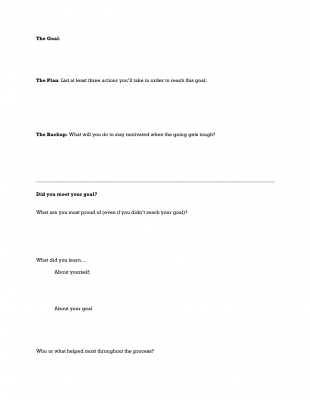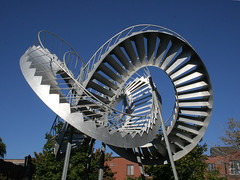
- Image via Wikipedia
January classes are probably well under way. However, there is no time like the present for you and your students to set goals for the coming months. January is a great time to take a little time out to guide students in setting goals and planning how they’ll achieve them.
If you are midway through your season, now may be a good time to meet individually with older students about their progress and goals for the year.
Short or long-term goals could be set for an entire class as well. Have the students work together on planning some group objectives.
Even very young students could learn an important lesson on planning and reaching goals.
Talk about January being a month when many people think ahead and decide how they’ll get from one place to another.
- Practice with each exercise, selecting a goal such as remembering to point their toes on each sauté.
- Practice setting goals and sticking to them. For instance, the goal may be staying quiet as students wait their turn to go across the floor. Ask for suggestions on what they will do instead (watch closely) and then have them choose a method to make sure they are watching (each dancer strikes a pose when they finish their progression and it is the job of everyone else to copy their body shape).
- Literally practice pathways that start at A and end at B, then allow each individual dancer to choose the movements, rhythms, or methods to get there. Discuss how there are many ways to reach the same goal and have them explore which choices worked best, or fastest, or were the most fun.
I know time in the studio is always precious but with older students, take time out of class to discuss how to set realistic goals for technique, flexibility, or performance. The time spent will be worth it if each student stays focused with clear steps on how they’ll hit their target. Students could try coming up with both a short-term goal (one month) and a long-term one (6 months or a year).
Below is a one-page form that can help students plan their strategy.

The top half of the page asks the student to set a goal. For example, the dancer may want to be able to do a triple pirouette.
Then, it has the student list specific steps they’ll take to reach this goal. For instance, the dancer may do Theraband exercises at home to strengthen weak or wobbly ankles, spend the moments before class on warming up with core exercises instead of chatting or stretching, test and challenge her balance throughout class (at the end of each exercise, by taking the hand off the barre occasionally, etc.). Help your students break down their goal into these manageable pieces.
Then the form helps them prepare for the inevitable moment when they lose their focus or motivation. This backup plan could be asking a classmate to join her in the warm-up, or watching an inspiring video of professionals turning, or picking one favorite television program during which she’ll sit and do the exercises.
The bottom half of the form is to be completed when the desired window of time has closed. Six months later, has your student been able to consistently do a triple pirouette? You could collect all of your student’s worksheets in a notebook until it is time to revisit them. When you do, the form offers some questions of reflection that work even if the goal was not attained.
Remember, your students will probably need some help with this exercise. Encourage thoughtful planning and creativity, offer examples, and suggestions if they need them. Good Luck!
What are some other ways you could put goal-setting into practice in your classroom?
Nichelle Suzanne is a writer specializing in dance and online content. She is also a dance instructor with over 20 years experience teaching in dance studios, community programs, and colleges. She began Dance Advantage in 2008, equipped with a passion for movement education and an intuitive sense that a blog could bring dancers together. As a Houston-based dance writer, Nichelle covers dance performance for Dance Source Houston, Arts+Culture Texas, and other publications. She is a leader in social media within the dance community and has presented on blogging for dance organizations, including Dance/USA. Nichelle provides web consulting and writing services for dancers, dance schools and studios, and those beyond the dance world. Read Nichelle’s posts.


![Reblog this post [with Zemanta]](https://img.zemanta.com/reblog_e.png?x-id=dee63c4d-776e-4c9c-942c-627049c2300b)
